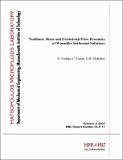| dc.contributor.author | Yesilata, B. | |
| dc.contributor.author | Clasen, Christian | |
| dc.contributor.author | McKinley, Gareth H. | |
| dc.date.accessioned | 2006-02-14T16:46:48Z | |
| dc.date.available | 2006-02-14T16:46:48Z | |
| dc.date.issued | 2005-10-04T16:46:48Z | |
| dc.identifier.uri | http://hdl.handle.net/1721.1/31209 | |
| dc.description | Accepted for publication in JNNFM. | en |
| dc.description.abstract | Nonlinear shear and extensional flow dynamics of rheological properties of a wormlike
micellar solution based on erucyl bis (2-hydroxyethyl) methyl ammonium chloride, EHAC, are reported here. The influences of surfactant (EHAC) and salt (NH4Cl) concentrations on the linear viscoelastic parameters are determined using small amplitude oscillatory shear experiments. The steady and time-dependent shear rheology is determined in a double gap Couette cell, and transient extensional flow measurements are performed in a Capillary Breakup Extensional Rheometer (CABER). In the nonlinear shear flow experiments, the micellar fluid samples show strong hysteretic behavior upon increasing and decreasing the imposed shear stress due to the development of shear-banding instabilities. The non-monotone flow curves of stress vs. shear rate can be successfully modeled in a macroscopic sense by using the single-mode Giesekus constitutive equation. The temporal evolution of the flow structure of the surfactant solutions in the Couette flow geometry is analyzed by instantaneous shear-rate measurements for various values of controlled shear-stress, along with FFT analysis. The results indicate that the steady flow bifurcates to a global time-dependent state as soon as the shear banding/hysteresis regime is reached. Increasing the salt/surfactant ratio or the temperature is found to stabilize the flow, as also confirmed by the decreasing values of anisotropy factor in the Giesekus model. Finally we have investigated the dynamics of capillary breakup of the micellar fluid samples in uniaxial extensional flow. The filament thinning behavior of the micellar fluid samples is also accurately predicted by the Giesekus constitutive equation. Indeed quantitative agreement between the experimental and numerical results can be obtained providing that the relaxation time of the wormlike micellar solutions in extensional flows is a factor of three lower than in shear flows. | en |
| dc.description.sponsorship | NSF, Schlumberger, and the Turkish Scientific and Technical Research Institute | en |
| dc.format.extent | 890751 bytes | |
| dc.format.mimetype | application/pdf | |
| dc.language.iso | en_US | en |
| dc.relation.ispartofseries | 05-P-11 | en |
| dc.subject | worm-like micelles | en |
| dc.subject | flow instability | en |
| dc.subject | shear-banding | en |
| dc.subject | capillary thinning | en |
| dc.title | Nonlinear Shear and Extensional Flow Dynamics of Wormlike Surfactant Solutions | en |
| dc.type | Preprint | en |
